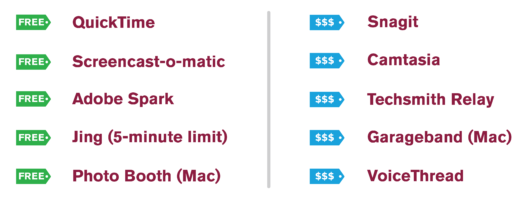A Brief Guide to Producing Videos from Your Home or Office
Written by Jessica Cole and Robert Behnke.
The benefits of instructor-created video in online courses include increased student engagement and learning, increased instructor presence, and a greater student-to-instructor connection.[1-3] If you teach online but do not have immediate access to a media studio or multimedia developer, this brief guide will help you get started.
What You Need
- Equipment: Webcam, video camera or mobile device.
- Recording Software: Software for recording video includes Quicktime, Camtasia, Screencast-o-matic, and free tools such as Jing.
- Streaming Video Server: Your video should be hosted on a server to stream through Blackboard or another Learning Management System. Videos can be streamed from YouTube, Vimeo, or Wistia, to name a few.

Planning
- Choose Talking Points: Nothing is more important than knowing what you are going to say. Prepare a brief outline of what is most important to include. Practice! Do a run-through with a friend, family member, or trusted colleague. We recommend that you get comfortable with the material ahead of time so you are prepared to speak naturally, rather than reading to the camera.
- “Chunk” the Material: Shorter lectures are more engaging in the online environment. Researchers at MIT found that many students stopped viewing videos that exceeded nine minutes about halfway through.[1] We recommend keeping each video under ten minutes in length. Covering a lot of content? Create multiple, clear and concise video segments.[3,4]
- Set the Stage: Choose a well-lit recording location. Be mindful of what will appear behind you. We recommend one of these backgrounds: a clean and simple background that keeps the focus on you, or an office-like background for a more personal touch.
- Dress for Success: Wear something that increases your confidence and conveys an appropriate level of professionalism.
Lights, Camera, Action
- Light: Avoid strong backlighting, which occurs when light is behind you. It is best to face the light source.
- Audio: Stand within 24″ of the microphone/camera. Closer is better.
- Camera Position & Framing: The camera should be level with your head and shoulders and not pointing up or down at you. Frame the shot with your head, neck, and part of the shoulders/chest visible, similar to a portrait bust.
Best Practices Infographics
- Audio/Video Best Practices for Making Web Camera Video
- Audio/Video Best Practices for Shooting With a Mobile Device
Videos for instructional purposes should be technologically well-produced, but they do not need to be perfect. Don’t be too hard on yourself about mannerisms, your hair, or stumbling over a word here and there. Students want to learn from you, and the benefit of a more casual lecture approach is increased personal connection.
Tools Available to ASU Online Instructors
- Screencast-o-matic: Recording software that is great for screencasting. ASU instructors may request an account & find tutorials here: https://screencast-o-matic.com/asu-som
- VoiceThread: With this tool, instructors create lectures that students may also record and post “voice” comments on for class discussion purposes. Contact your Instructional Designer for more information.
- Wistia: See “How to record a web camera video in Wistia” at http://onlinestudio.asu.edu/wistia-2. Contact your Instructional Designer for access to Wistia.
References
- Di Paolo T, Wakefield JS, Baker L. Lights, camera, action: Facilitating the design and production of effective instructional videos. Tech Trends. 2017 ;61:452-460.
- Guo PJ, Kim J, Rubin R. How video production affects student engagement: An empirical study of MOOC videos. Available at: http://up.csail.mit.edu/other-pubs/las2014-pguo-engagement.pdf. 2014.
- Martin F, Wang C, Sadaf A. Student perception of helpfulness of facilitation strategies that enhance instructor presence, connectedness, engagement and learning in online courses. The Internet and Higher Education. 2018; 37:52-65.
- Pappas C. 3 chunking strategies that every instructional designer should know. eLearning Industry.com Web site. https://elearningindustry.com/3-chunking-strategies-that-every-instructional-designer-should-know. 2013.
The technology mentioned in this article was updated in July 2019.



